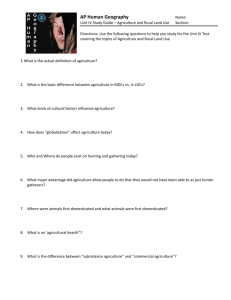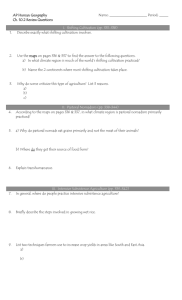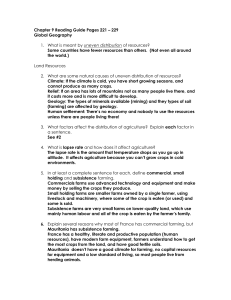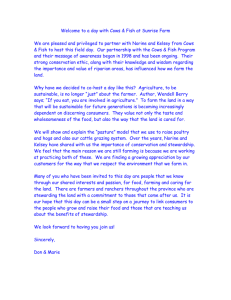PPT
advertisement
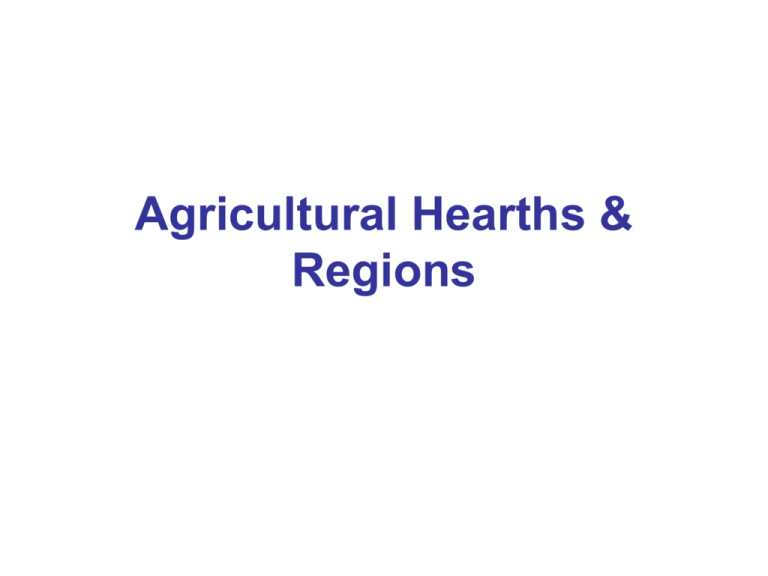
Agricultural Hearths & Regions Agricultural Hearths • Origins of both vegetative and seed agriculture • Mapped out by Carl Sauer • Sauer believed humans had power over their environment and weren’t simply the product of their environment. 2 Distinct Kinds of Agriculture • 1. Vegetative Planting – Removing part of the plant and putting it in the ground to grow a new plant. – Ex: fruits and berries • 2. Seed Agriculture – Taking seeds from existing plants and planting them to produce new plants. – Most farmers use this method today. Where did agriculture develop? • Three Areas of Vegetative Planting – 1. Central America & northwestern South America – 2. Western Asia – 3. Southeast Asia Where are the three hearths? Why are these the hearths? • All three had…. – Tropical regions with climates that were good for growing agricultural products – Large populations to provide a workforce to domesticate plants and animals native to the region. Central American & northwestern South American HEARTH • Who did it: Aztecs, Maya and Incas • Plants: Sweet potato, arrowroot, cotton • Animals: Turkeys, Llamas, Alpacas Western Asia HEARTH • Plants: Yams and Palm Oil • Animals: Cattle, Sheep, Goats Southeast Asian Hearth • Plants: Root crops such as taro, bananas, palm trees • Animals: Dogs, pigs, chickens Seed Hearths • 1. Central America & parts of Mexico • 2. Northeast portions of Africa, including Ethiopia • 3. Northern China • 4. Northeastern India • Practices diffused to other areas and are still practiced today. Southern Mexico Seed Hearth • Squash, beans, cotton Northeastern Africa Seed Hearth • Coffee • Diffused to Western Africa and then to South America with the slave trade. • Northern South American countries have prospered from the production of coffee. Northern China Seed Hearth • Millet Northeastern India • Rice Importance of trade routes • Helped to diffuse the agricultural products we use today. • Colonialism brought many products to the Western Hemisphere • Diffusion of agricultural products led to different styles of farming around the world. • Climate dictates what is grown there. • Ex: Lemons and Oranges don’t grow well in New England. Agricultural Regions & Types of Farming Two Types of Farming • Subsistence • Farmers produce the food that they need to survive on a daily basis. • Food is mostly consumed on the farm by the farmer and family. • Commercial • Farming of products for sale off the farm • Usually done in more developed countries • Usually requires use of machinery Types of Subsistence Farming • • • • • • Shifting Cultivation Crop Rotation Pastoral Nomadism Extensive Subsistence Agriculture Intensive Subsistence Agriculture Intertillage Shifting Cultivation • Moving of farm fields after several years in search of more productive soil after depleting the nutrients from the original field. • Usually takes place in tropical areas where soil erodes quickly due to moisture Shifting Cultivation • Farmer will just leave the old field empty and move to next field • To clear the next field he will often burn the vegetation there • This puts nitrogen into the soil, plants love nitrogen • SLASH AND BURN Agriculture Slash-and-burn agriculture • Process leaves scars • Picture: Slash and on land, the dirt left Burn from the air behind after the farmer is done is incapable of growing food. • It can take decades for the soil to return to normal • Puts rainforests and other native ecosystems at risk. Crop Rotation • Crop Rotationplanting of different types of crops each year to replenish the soil with nutrients used by the previous crop. • Ex: Plant corn one year, soybeans the next, and corn again. • Ex: Planting clover helps to replenish the nitrogen taken out of the soil by previous crops. Pastoral Nomadism • Pastoral Nomadismmoving animals on a seasonal basis to areas that have the necessary resources to meet the needs of the herd. • Usually practiced in arid climates that have little precipitation. • Ex: Sahara Desert in Northern Africa where nomads take their herds along trade routes. Extensive Subsistence Agriculture • Pastoral Nomadism & Shifting Cultivation fit in this category. • Extensive Subsistence has been criticized for causing soil erosion, water degradation and other environmental problems. Intensive Subsistence Agriculture • Intensive Subsistence is a type of agriculture that requires A LOT of work. • Ex: Wet Rice – Grown in a rice Sawah, requires lots of work by hand. Commercial Farming • Commercial Farming- farming of products for sale OFF the farm • Practiced in MDCs • Requires the use of machinery • Mass production of crops • Crops are produced at a reduced price and sold at an increased cost, depending on demand. Commercial Farming • Kansas • Dakotas Mediterranean Agriculture • Must be practiced in a climate that has a dry summer and a cool, moist winter. • Crops: Grapes, dates, olives. Mediterranean Agricultural Regions Dairy Farming • Mechanized milking of cows, cows are hooked up to milking machines. Dairy Farming: Milk Cows per acre by county Dairy Farming • Usually done relatively close to a major market. • Ex: Wisconsin held the title of “dairy state”. It is close to Chicago, Detroit, Milwaukee, & Minneapolis. • Milk can quickly be shipped to these areas and can be sold before it spoils. Why do we see this? What kind of map? Relative Location of Wisconsin? Aggregation? Where are the farms? Mixed Livestock with crop production • Cows, grown for their meat and other products, are fed with crops (corn & soybeans) that are grown on the farm. • Cows are sold by the pound, so the fatter the cow the more money the farmer gets. Livestock Ranching • Done on land that is on the fringe of productive land • Needs lots of space to allow animals to roam fields without a farmer Specialized Fruit Production • Large orchards dedicated to a specific fruit. • Southwestern & southeastern United States have a lot of this type of farming. • Ex: Oranges, lemons, limes, peaches, berries and apples. Plantation Agriculture • The plantation itself is in an LDC, while the owner of the plantation is in an MDC. • Ex: Bananas, sugarcane, coffee, and cotton are common plantations. Truck Farms • A farm where farmers produce fruits for the market and ship them in trucks. • Ex: Jolly Green Giant in Minnesota get their veggies from truck farmers • Many truck farms use migrant labor to keep costs low. Suitcase Farms • A farm in which no one resides permanently. • Worked by migrant workers who come to work on the farm as a job and go home to a residence off farm property. • Has led to rise of Agribusiness. Suitcase Farms & Agribusiness • Agribusiness- mass production of agricultural products. • Debate between Agribusiness & Family Farms Grain Farming • Mass Planting and Harvesting of grain crops (wheat, barley, millet) • Take up a huge amount of land • Ex: Great Plains in the United States is one of the largest regions in the world that specializes in the production of grain. Grain Production in US
